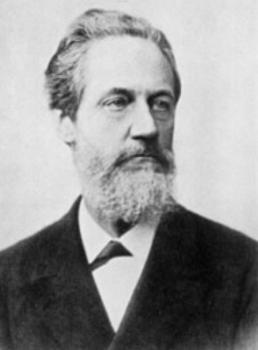German mechanical engineer and professor of applied mechanics.
Biographical Information
| Name: | Franz Grashof |
|---|---|
| Born on | 11 July 1826 in Düsseldorf, North Rhine-Westphalia, Germany, Europe |
| Deceased on | 26 October 1893 in Karlsruhe, Baden-Württemberg, Germany, Europe |
Short biography of Franz Grashof
When he was just 15 years old, Franz Grashof left school, initially in order to work for a locksmith. Later, he attended the industrial school in Hagen and then the secondary school in Düsseldorf. He studied at the Berlin Industrial Academy from 1844 to 1847. During the revolution of 1848, Grashof was forced into military service, whereupon he decided to join the German merchant fleet, but returned two-anda- half years later to resume his studies at the Industrial Academy. At the same Academy he became a teacher of mathematics and mechanics in 1854 and one year later director of the Royal Office of Weights & Measures in Berlin. Grashof founded the Verein Deutscher Ingenieure (VDI, Association of German Engineers) in 1856 together with other members of “Die Hütte”, the academic society of the Industrial Academy, and one year later the engineering pocketbook Hütte. In the role of its director, Grashof was to engineer the rise of the VDI to its position as Europe’s premier engineering association. After the death of Ferdinand Redtenbacher in 1863, Grashof succeeded him as professor at Karlsruhe Polytechnic, teaching strength of materials, hydraulics, thermodynamics and mechanical engineering theory. His work Theorie der Elasticität und Festigkeit mit Bezug auf ihre Anwendungen in der Technik (1878) influenced applied mechanics in the period between Julius Weisbach and August Föppl. He prepared St. Venant’s bending and torsion theories as well as Clebsch’s Theorie der Elasticität fester Körper (1862) for the practical needs of engineers although he was an advocate of the deductive method. Grashof always paid attention to the academic presentation. This makes sense when we remember that he was a successful champion of pure academic expansion and the free constitution of the technical polytechnics; he saw that as a prerequisite for equality with universities. Grashof ’s name stands for the emancipation of the engineering science disciplines from mathematics and theoretical physics at the transition from the establishment to the classical phase. His achievements were widely acclaimed, e. g. an honorary doctorate from the University of Rostock and, posthumously, the Grashof Memorial Medal, awarded annually by the VDI.
Main contributions to structural analysis:
Die Festigkeitslehre mit besonderer Rücksicht auf die Bedürfnisse des Maschinenbaues. Abriss von Vorträgen an der Polytechnischen Schule zu Carlsruhe [1866]; Theorie der Elasticität und Festigkeit mit Bezug auf ihre Anwendungen in der Technik [1878]
Source: Kurrer, Karl-Eugen The History of the Theory of Structures, Wilhelm Ernst & Sohn Verlag für Architektur und technische Wissenschaften GmbH, Berlin (Deutschland), ISBN 3-433-01838-3, 2008; p. 734
Relevant Websites
Relevant Publications
- (2008): The History of the Theory of Structures. From Arch Analysis to Computational Mechanics. 1st edition, Wilhelm Ernst & Sohn Verlag für Architektur und technische Wissenschaften GmbH, Berlin (Germany), ISBN 978-3-433-01838-5, pp. 848.
- (2018): The History of the Theory of Structures. Searching for Equilibrium. 2nd edition, Wilhelm Ernst & Sohn Verlag für technische Wissenschaften, Berlin (Germany), ISBN 978-3-433-03229-9, pp. 1001.
- About this
data sheet - Person-ID
1009822 - Published on:
11/08/2013 - Last updated on:
22/07/2014





